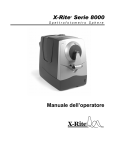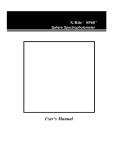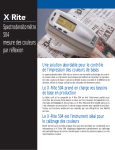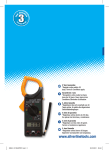Download Rite Life Sensitometer 394 User's Manual
Transcript
393/394 Sensitometer Operation Manual FCC This equipment has been tested and found to comply with the limits for a Class A digital device, pursuant to Part 15 of the FCC Rules. These limits are designed to provide reasonable protection against harmful interference when the equipment is operated in a commercial environment. This equipment generates, uses, and can radiate radio frequency energy and, if not installed and used in accordance with the instruction manual, may cause harmful interference to radio communications. Operation of this equipment in a residential area is likely to cause harmful interference in which case the user will be required to correct the interference at his own expense. Canada This digital apparatus does not exceed the Class A limits for radio noise emissions from digital apparatus set out in the Radio Interference Regulations of the Canadian Department of Communications. Le present appareil numerique n'emet pas de bruits radioelectriques depassant les limites applicables aux appareils numeriques de la class A prescrites dans le Reglement sur le brouillage radioelectrique edicte par le ministere des Communications du Canada. CAUTION: Reverse connection of battery may cause damage to circuit. Use only 9-volt alkaline batteries. VORSICHT: Eine umgekehrte Verbindung zur Akku könnte die Schaltung beschädigen. Verwenden Sie nur 9 Volt- Alkalibatterien. ADVERTENCIA: Conexión inversa de las pilas causaría daño al circuito. Use solamente las pilas alcalinas de 9 voltios. ATTENTION: Un raccordement inversé des piles peut endommager le circuit. Utiliser seulement des piles fernickel de 9 volts. AVVERTIMENTO: Connesione inversa delle pile può causare danno al circuito. Usare solamente le pile alcaline di 9 volt. i CE DECLARATION Manufacturer’s Name Manufacturer’s Address: X-Rite, Incorporated 3100 44th Street, S.W. Grandville, Michigan 49418 U.S.A. Model Name: Model No.: Sensitometer 393 and 394 Directive(s) Conformance: EMC 89/336/EEC WARNING This is a class A product. In a domestic environment this product may cause radio interference in which case the user may be required to take adequate measures. Proprietary Notice The information contained in this manual is derived from patent and proprietary data of X-Rite, Incorporated. This manual has been prepared solely for the purpose of assisting in the use and general maintenance of this instrument. The contents of this manual are the property of X-Rite, Incorporated and are copyrighted. Any reproduction in whole or part is strictly prohibited. Publication of this information does not imply any rights to reproduce or use this manual for any purpose other than installing, operating, or maintaining this instrument. No part of this manual may be reproduced, transcribed, transmitted, stored in a retrieval system, or translated into any language or computer language, in any form or by any means, electronic, magnetic, mechanical, optical, manual, or otherwise, without the prior written permission of an officer of X-Rite, Incorporated. ©2002 by X-Rite, Incorporated. “ALL RIGHTS RESERVED” ii Limited Warranty X-Rite, Incorporated warrants each unit manufactured to be free of defects in material and workmanship for a period of twelve months. If the fault has been caused by misuse or abnormal conditions of operations, repairs will be billed at a nominal cost. In this case, an estimate will be submitted before work is started, if requested. The unit shall be returned with transportation charges prepaid. There are no warranties of merchantability or fitness. This warranty obligation is limited to servicing the unit returned to X-Rite, Incorporated or an authorized dealer for that purpose. X-Rite, Incorporated offers a repair program for instruments out of original warranty coverage. For more information, contact X-Rite Customer Service at: 1-888-826-3044. Always include serial number in any correspondence concerning the unit. The serial number is located on the bottom of the instrument. This agreement shall be interpreted in accordance with the laws of the State of Michigan and jurisdiction and venue shall lie with the courts of Michigan as selected by X-Rite, Incorporated. iii Table Of Contents 1. Getting Started ...................................... 1 Unpacking and Inspection ..................... 1 Instrument Description........................... 2 Applying Power...................................... 3 2. Application and Procedures................. 4 Sensitometer Monitoring For Process Control ................................................... 4 Processing Procedure ........................... 6 Manual Data Recording Procedure........ 7 Automatic Data Recording Procedure— Using the 391 Densitometer .................. 9 Processor Troubleshooting.................. 10 3. Using the Sensitometer ...................... 11 Setting Exposure Color........................ 11 Selecting Single or Dual Exposure (394 only)............................................. 12 Adjusting Exposure Setting (393) ........ 12 Adjusting Exposure Setting (394) ........ 13 Exposing Film ...................................... 14 4. General Maintenance .......................... 16 Repair Information ............................... 16 Calibration/Recertification.................... 16 Cleaning the Instrument....................... 17 Replacing the Battery .......................... 18 5. Technical Specifications .................... 19 iv 1. Getting Started Unpacking and Inspection After removing the instrument from the shipping carton, inspect for possible damage. If any damage has occurred during shipping, immediately contact the transportation company. Do not proceed with installation until the carrier’s agent has inspected the damage. If damage is not evident, check to make sure that the following items are included: • • • • • Sensitometer (393 or 394) Operation Manual (this document) Certificate of Calibration Registration Card Important Notice Your instrument was packaged in a specially designed carton to assure against damage. If reshipment is necessary, the instrument should be packaged in the original carton. If the original carton is not available, contact X-Rite at: 1-888-826-3044 to have a replacement shipped to you. 1 Instrument Description The Process Optimization Sensitometer is a battery operated, dual color, single or dual (394 only) sided exposure sensitometer, designed for quality control of cine and X-ray processing systems. It produces a repeatable stepped exposure on applicable film. Its ease of operation enables anyone with little instruction to expose repeatable sensitomerty strips, with either blue or green exposing light—simulating the light from blue and green intensifying screens. Advanced low-power circuitry allows a long battery life without sacrificing performance. Replacement battery is a “9 Volt” alkaline type. Exposure Button Single/Dual Exposure Switch (394) Power Switch (393) Color Switch 2 Applying Power The sensitometer is shipped from the factory with the battery installed and power switch in the “Off” (left) position—slide switch to the “On” (right) position. The battery switch for the 393 is located on the front of the instrument. The battery switch for the 394 is located on the bottom of the instrument. Because there is no drain on the battery during non-use times, the power switch can remain in the “On” position. The only time that the power switch must be turned “Off” is when the instrument is transported or the battery replaced. Your sensitometer is designed to operate from a “9 Volt” alkaline battery for approximately one year. When the battery is low, the circuit will not allow any exposures to occur. Should your unit become inoperative, replace the battery first, refer to Section Five. If this does not rectify the problem, refer the instrument to X-Rite or an authorized service center for proper servicing. There are no user serviceable components in the sensitometer. 3 2. Application and Procedures Sensitometer Monitoring For Process Control The sensitometer exposes film with a known quantity of light through a 21-step light modulator. The maximum light is emitted from Step No. 21. Each successive step emits approximately 70.7% of the light emitted from the step adjacent to it (.15 log exposure). The processed film responds to this exposure in a predictable manner. A plot of optical density—measured on the processed film—against relative log exposure values is known as the D-Log E curve. Figure One shows the response of a typical radiographic film to exposure with the sensitometer. The portion of the curve that changes most with variations in processing is called the “straight line portion” of the curve. It is not necessary to plot D-Log E Curves to monitor automatic processors in normal laboratory environments. A simpler method is to record the three parameters from the D-Log E Curve which contain most of the data. The following three parameters on the curve should be monitored to give pertinent processing data. • • Base+Fog: Step No. 1 on the D-Log E Curve is called Base+Fog the least exposed portion of the film. It is the base support density plus any silver emulsion density developed in the area where negligible exposure should occur. Speed Index: The step on the exposed film with a density nearest 1.OD+ Base+Fog is called Speed Index. This step is a direct indicator of film speed. 4 Variations in processor conditions are monitored on this step. • Contrast Index: An indicator of the slope of the straight-line portion of the D-Log E Curve is called Contrast Index. Select the step closest to but not larger than 2.20D. Subtract from this step the step closest to but not lower then 0.45D. Contrast Index is used to monitor processor variations in conjunction with the Speed Index. FIGURE 1. D-Log E Curve Optical density versus relative log exposure for typical radiographic film. SPEED INDEX CONTRAST INDEX BASE+FOG Selection and Use of Film 5 The film selected to monitor a given processor should be representative of the film used with that processor. Scheduling Sensitometric Control Every processor in use should have a separate control chart plotted to monitor its behavior. The more frequent the data points, the better the control feedback. A control film should be run at start-up of the processor and at least once a day. Use sensitometry whenever trouble is suspected, or a change has been made to the process. Processing Procedure 1. Allow the processor temperature and chemistry to reach equilibrium when starting up the processor before processing film. X-Rite 1 2 3 4 5 2. Films should be processed immediately after being exposed. Any delay between exposure and processing should be consistent from film to film. 3. Run a full width film for cleanup at start-up. 4. Orient the film into the processor in a consistent manner— making sure the film is inserted per processor manufacturer's specification. 6 6 7 8 9 10 11 12 13 14 15 16 17 18 19 20 21 TIME: DATE: ID NO: 5. After processing of film is complete, record the date, time, and processor identification number on the film in the designated areas. Manual Data Recording Procedure Establishing Normal Speed Index, Contrast Index, and Base+Fog The normal speed index, contrast index, and base+fog values are established on a representative film, when the processor is considered to be operating in an optimum fashion. Run several film samples and determine the average values for speed index, contrast index, and base+fog, using a transmission densitometer. Step wedge areas are as uniform as is possible to produce. There are, however, some errors at the edges of the step area. Therefore, always measure density at the center of the step. Use a 2mm aperture to give best repeatability. Record the following data on the process control record. • • • • Developer Temperature - Temperature of developer solution in processor during processing Normal Base+Fog - Step number one density, the least exposed step on the wedge. Normal Speed Index - The density of the step closest to 1.0D + base+fog. The step number should remain the same for a given processor and film type. Normal Contrast Index - Select the step closest to but not larger than 2.20D. Subtract from this step the step closest to but not lower than 0.45D. 7 NOTE: Monitor subsequent films on the same steps selected for normal contrast index. • • • • • • • • • • Date - Month - Day – Year Processor Number - Processor identification Emulsion Number - Film batch identification Developer Type - Developer vendor identification Fixer Type - Fixer vendor identification Film Type - Film vendor identification Exposure Color - Exposure light (blue or green) Developer Replenisher Rate - The rate of developer replenishment Fixer Replenisher Rate - The rate of fixer replenishment Processing Time - Film process time, input-tooutput A box of film should be set aside from regular stock for exclusive sensitometer use. New film stock will require re-establishment of normal values because small density changes are possible between film batches. Daily Plotting of Data on Process Control Record Plot the Speed Index, Contrast Index, Base+Fog, and Developer Temperature results on the process control record each time a control film is developed. Record data immediately so that it is not lost or changed. 8 Automatic Data Recording Procedure—Using the 391 Densitometer When the X-Rite 391 densitometer is used to measure process control films, it will automatically calculate and store the values for: speed index, contrast index, and base+fog. The unit will also store up to 32 measurements of film data for twelve processors. Printing Process Control Records The 391 densitometer will printout the process control record when interfaced to a printer (see below). 9 Processor Troubleshooting When troubleshooting out of tolerance processor conditions, use Speed Index as the primary guide. Speed Index is the most predictable indicator for all film types. Base+Fog is predictable, but is the least sensitive. Contrast Index reacts predictably for a given set of film conditions but may vary from film to film. Listed below is a chart showing Speed Index and Base+Fog reactions to common processor problem conditions. As Control Records become more complete for a given film, the relationships between Contrast Index and Processor Conditions will become apparent. Always note the reason for out-of-tolerance processor condition on the Control Record. NOTE: When out-of-tolerance conditions are noticed, always verify results with another test film before making any processor adjustments. Speed Index Base+Fog Possible Cause High High or Normal Developer temperature too high. Developer over replenished. Improper safe lighting. Improper solution mix. Low Low or Normal Developer temperature too low. Developer under replenished. Inadequate developer circulation. Improper solution mix. Contaminated developer. 10 3. Using the Sensitometer Setting Exposure Color Optimum sensitometric control occurs when the proper color light exposes the film. Expose with the same color emitted from the intensifying screen recommended by the film manufacturer for the film being exposed. For example, when using blue emitting intensifying screen—expose in “BLUE” position. Slide the color switch on the front of the unit to the left for “BLUE” or to the right for “GREEN.” NOTE: The exposure time should be set in accordance with the manufacturers requirements. See Adjusting Exposure Setting on the following pages. 11 Selecting Single or Dual Exposure (394 only) Depending on the type of film that is to be exposed, the sensitometer can have either single sided or doublesided exposure selected. If the film to be exposed is a single emulsion type, slide the exposure switch to the “SINGLE” position and expose Emulsion Side Down. Expose double emulsion type films in the “DUAL” switch position. Adjusting Exposure Setting (393) The sensitometer has the capability of seven different exposure times for both blue and green. The factory preset exposure setting is #3. If different exposure times are required, refer to the chart on the next page—or bottom of unit—for the settings. Each exposure setting will move the speed index on the film one step. The dipswitch used to change the exposure time is located on the bottom of the unit. When the blue color is selected, switches A,B,C,D bracketed as blue are 12 activated. When the green color is selected, switches A,B,C,D bracketed as green are activated. Exposure Setting 1 MIN 2 3 4 5 6 7 MAX A OFF ON OFF OFF ON OFF OFF B OFF OFF ON OFF ON OFF OFF C OFF OFF OFF ON ON OFF ON D OFF OFF OFF OFF OFF ON ON Adjusting Exposure Setting (394) The sensitometer has the capability of seven different exposure times for both single and dual. The factory preset exposure setting is “3” for both single and dual. If different exposure times are required, refer to the chart below—or bottom of unit—for the settings. Each exposure setting will move the speed index on the film one step. The dipswitch used to change the exposure time is located on the bottom of the unit. When single emulsion is selected, switches A,B,C,D bracketed as “SINGLE” are activated. When the dual emulsion is selected, switches A,B,C,D bracketed as “DUAL” are activated. Exposure Setting 1 MIN 2 3 4 5 6 7 MAX A OFF ON OFF OFF ON OFF OFF 13 B OFF OFF ON OFF ON OFF OFF C OFF OFF OFF ON ON OFF ON D OFF OFF OFF OFF OFF ON ON Exposing Film Expose the selected film as follows: 1. Select exposure color—blue or green. 2. Select single or dual exposure (394 only). 3. Adjust exposure setting if required. 4. Insert the film—emulsion side down if single— with the back edge against the stop, and the film centered in the unit. 5. Press the expose button down and hold until the buzzer has sounded. Always press straight down with firm, even pressure across expose button. 14 6. Release the expose button and remove the film immediately. 7. Develop the film in the processor to be monitored (refer to Section 2). 8. Record data on film immediately after development (refer to Section 2). IMPORTANT NOTES: • • • Film must be inserted all the way to the back of the unit in order to be exposed properly. The sensitometer is calibrated to expose screentype films normally used for general radiography to an approximate density of 1.OD+ Base+Fog on Step No. 11. If the X-Rite 390/391 Densitometer is used to measure film strips, the sensitometric exposure must meet the following criteria: - The exposure must have a gamma of .7 or greater on steps 7 through 15. (increasing density increments of at least .11D). - The film must have at least 1.25 inch of clear leader at both ends of the exposure. The use of 8" x 10" or 18cm x 24cm film is recommended. 15 4. General Maintenance Repair Information Your 393/394 Instruments are covered by a one-year limited warranty—excluding alkaline battery—and should be referred to the factory for repair within the warranty period. Attempts to make repairs within this time frame may void the warranty. X-Rite provides a factory repair service to their customers. Because of the complexity of the circuitry, all repairs should be referred to the factory. X-Rite will repair any 393/394 past warranty. The customer shall pay shipping cost to the factory, and the instrument shall be submitted in the original carton, as a complete, unaltered unit. Calibration/Recertification X-Rite sensitometers are calibrated at exposure setting “3” at the factory. The exposure of Step 11 is adjusted to match factory standard instruments maintained by XRite. A certificate of calibration is provided with each instrument, along with a calibration sticker that is initialed and dated by the Quality Assurance Inspector. Because calibration requires a master instrument for comparison, sensitometers do not have user accessible calibration adjustments. X-Rite offers a recertification program to verify sensitometer calibration. Recertification is recommended every 12 months and can be arranged through X-Rite’s Customer Service Department. 16 Cleaning the Instrument Your instrument requires very little maintenance to achieve years of reliable operation. However, a few simple cleaning procedures should be performed from time to time. General Cleaning The exterior of the instrument may be wiped clean with a cloth dampened in water or a mild cleaner, whenever required. NOTE: DO NOT use any ketone solvents to clean the unit, this will cause damage to the cover. Cleaning the Step Tablet The step tablet should be cleaned of dust and lint periodically to maintain consistent exposures. 1. Holding air can in upright position, insert tube into exposure slot. Make sure the air is clean and free of moisture. 2. Using a back-and-forth motion, spray air in to exposure slot from one end to the other—do this several times. This procedure should remove any accumulated dust and lint. 17 Replacing the Battery A low battery condition prevents exposures from occurring. Always Replace The Battery before referring the unit for service. 1. Turn Power Switch “Off” and remove battery access cover by sliding outward. 2. Disconnect old 9-Volt battery from the circuit and discard. WARNING: Connecting the battery leads backward may cause circuit failure. 3. Connect a replacement 9 Volt Alkaline battery to the circuit—recognizing proper polarity—and insert into the compartment. 4. Reinstall battery access cover and turn power “On.” Battery Access Cover 9-Volt Alkaline Battery 18 5. Technical Specifications Design Conformance: A.N.S.I. PH2.9-1974* Unit-to-Unit Repeatability: ±.02 Log Exposure Exposure Stability: ±.02 Log Exposure per year Temperature Sensitivity: ±.02 Log Exposure from 59°F (15°C) - 86°F (30°C) Electrical Required: 9-Volt alkaline battery Light Modulation: 21-Step Wedge, 0.15D per step Blue Color Peak Wavelength: 460nm ±10nm Green Color Peak Wavelength: 510nm ±10nm Warm-up Time: Instantaneous Recycle Time: 2 Seconds Dimensions: 8.5in. (21.59cm) W x 5.25in. (13.34cm) D x 3.0in (7.62cm) H Weight: 2-1/2 lbs. (1.13kg.) * American National Standards Institute compliance except as noted. This instrument may be covered by one or more patents. Refer to the instrument for actual patent numbers. Specifications and design subject to change without notice. 19 20 X-Rite, Incorporated - World Headquarters 3100 44th Street S.W. • Grandville, Michigan 49418 • USA www.x-rite.com • Tel: 1-888-826-3044 Fax: 1-888-826-3045 or (616)-534-0686 International Tel: 1-888-826-3039 or (616) 534-7663 Fax: (616) 534-0723 X-Rite GmbH Stollwerckstraße 32 • 51149 Köln • Germany Tel: (49) 22 03 - 91 45-0 • Fax: (49) 22 03 – 91 45-19 X-Rite GmbH Sochorova 705 • CZ-682 • 11 Vyskov • Czech Republic Tel: (420) 507-328197 • Fax: (420) 507-328138 X-Rite Asia Pacific Ltd. Room 808-10 • Kornhill Metro Tower • 1 Kornhill Road Quarry Bay • Hong Kong • Tel: (852) 2-568-6283 Fax: (852) 2-885-8610 X-Rite Ltd. The Acumen Centre • First Avenue Poynton, Cheshire • England Tel: 44-0-1625-871100 • Fax: 44-0-1625-871444 X-Rite Méditerranée Parc du moulin de Massy • 35, rue du Saule Trapu 91300 Massy • France Tel: 33-1-69.53.66.20 • FAX 33-1-69.53.00.52 X-Rite Italy Srl Via per Caronno, 35 21040 Origgio (Va) • Italy Tel. 0039 02 96734266 • Fax. 0039 02 96730681 X-Rite K.K. 4F, 3-19-18 Shibaura, Minato-ku Tokyo • 108-0023 Japan Tel: +81-3-5439-5971 • Fax: +81-3-5439-5972 X-Rite Asia Pacific Ltd. Singapore Representative Office 14 Science Park Drive • #02-04 The Maxwell Singapore Science Park • Singapore 118226 Tel: + 65 7788-773 • Fax: + 65 7788-645 P/N 393-500 Rev. O-4/28/04





































